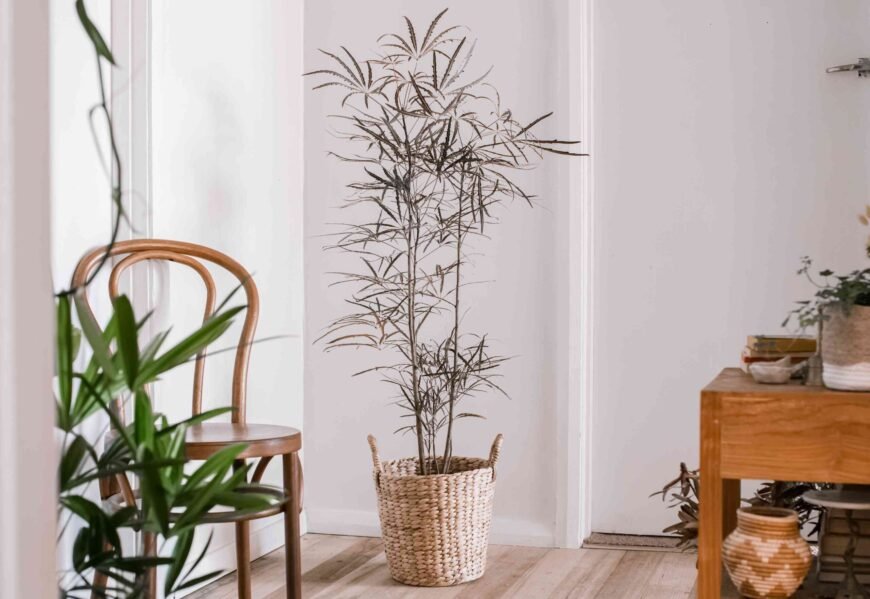| Common Name | False aralia |
| Botanical Name | Plerandra elegantissima |
| Family | Araliaceae |
| Plant Type | Perennial |
| Mature Size | 6 ft high, 2-3 ft. wide |
| Sun Exposure | Partial |
| Soil Type | Moist |
| Soil pH | Acidic, neutral |
| Bloom Time | Summer, fall |
| Flower Color | Green |
| Hardiness Zones | 10-12 (USDA) |
| Native Area | South Pacific |
False Aralia Care
Here are the main care requirements for growing false aralia:
- Plant in moist, well-draining soil, in an area with partial sun exposure or near a window.
- Water just before the soil dried out.
- Provide consistent humidity, especially indoors during colder months.
- Maintain average room temperature around false aralia, protecting it from cold.
Light
Place false aralia in a spot with bright, indirect light. The leaf color is affected by overall light levels—the more light it gets, the darker the mature leaves will appear. Be mindful of exposing the plant to any harsh direct rays of sunlight, which can cause damage.
Soil
Plant false aralia in moist but well-draining soil with a slightly acidic to neutral soil pH. It does not do well in sponge-like potting media, so opt for a peat-based mix instead. Make sure your chosen blend has plenty of coarse material to promote drainage.
Water
Provide a steady supply of moisture for false aralia prefers a steady supply of soil moisture, but keep it out of soggy soil. Water just before the soil dries out completely. Check weekly with a moisture meter to see if it’s time to water. When growing outdoors, protect false aralia from drought.
Temperature and Humidity
Protect false aralia from the cold. The ideal temperature range for false aralia to thrive is somewhere between 65 and 85 degrees, though it can handle brief dips in temperature to about 45 degrees. However, prolonged cold temperatures can kill the plant.
Additionally, false aralia loves humidity and will need humidity levels of at least 50 percent to thrive. To raise humidity, you can use a humidifier, place the plant on a pebble tray, or keep it in a bathroom or laundry room.
Fertilizer
Generally, false aralia doesn’t have any heavy fertilizer requirements. However, you can give your plant a boost with a liquid houseplant fertilizer during its growing season (spring and summer), following label instructions.
Types of False Aralia
There are some varieties of false aralia to consider, including:
- ‘Galaxy’ false aralia has shiny, dark green leaves that are more clustered than other varieties.
- ‘Variegated Galaxy’ false aralia has dark green leaflets that are edged in a golden hue.
- ‘Gold Crest’ false aralia is a more feathery leafed variety with lighter green leaves edged in gold.
- ‘Olympia’ false aralia is the most “colorful” variety, with dark green leaves among shade of reds and violet.
Propagating False Aralia
False aralia can be propagated relatively easily via stem cuttings. Not only is this an inexpensive way to make new plants, but it also allows you to make use of any stems you want to prune off the parent plant to shape it. The best time to take a stem cutting is in the spring. Here’s how:
- Using a pair of sharp pruning shears, cut a few stems.
- Place the stem cuttings in a container of moist soil.
- Place the container in the window where it will receive bright, indirect light.
Potting and Repotting False Aralia
To pot false aralia, select a container that’s just slightly larger in both width and depth than your plant’s root ball. This plant doesn’t mind being a little root-bound. An unglazed clay container with drainage is ideal.
Because this plant is slow-growing, you likely will only have to repot every other year. If you see roots growing out of the drainage holes or popping up out of the soil, you’ll know it’s time to repot. The best time to repot is in spring or early summer.
Common Pests & Plant Diseases
This plant is susceptible to common pests, including spider mites, scale, aphids, and mealybugs. Infestations can often be treated with insecticidal soap or neem oil. The most common plant disease that plagues false aralia is root rot, which is usually due to overwatering.
Common Problems with False Aralia
Leaves Turning Yellow
If the leaves begin to turn yellow, that often can be a sign of overwatering.
Leaves Turning Black or Brown
If you notice leaves turning black or brown, that can be a sign of too much or too harsh of light. So try moving your plant to a shadier spot.
Plant Leaves Falling Off
If leaves start dropping off the plant, that sometimes can be the result of temperatures that are too chilly. Even nighttime temperatures should remain above 60 degrees, so always bring your plant indoors if you’re expecting a cold spell.
-
-
Yes. The main problem for false aralia is the lack of humidity that you may encounter during the cold season—especially when the heat is on indoors. Plants might lose some leaves unless you can raise the humidity sufficiently.
-
-
-
While false aralia plants like higher humidity, misting is not an effective way to really raise the humidity level of your home. Your plant will be better off in a more humid area, like a bathroom or laundry room. If this isn’t an option, consider using a humidifier in the same room as the plant.
-
-
-
No, full sun is not ideal for false aralia. This plant prefers bright, indirect light when grown indoors and partial shade outdoors.
-
